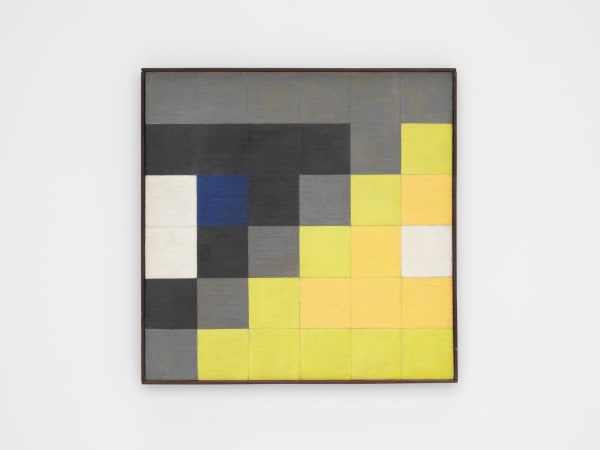Judith Lauand Brazilian, 1922-2022
Born in Pontal, São Paulo in 1922, Judith Lauand graduated from the Escola de Belas Artes de Araraquara in 1950, and moved to the city of São Paulo as the influence of European Concrete artists such as Max Bill and Josef Albers was taking hold. She is renowned in Brazil as the ‘Dama do Concretismo’ or ‘First Lady of Concretism,’ being the sole female member of Grupo Ruptura, the artist group who defined in their manifesto a rational and cerebral approach to geometric abstraction that would set in motion a distinctly Brazilian course of avant-garde art. Joining the group in 1955, she developed a practice within the bounds of their geometric language, working with precise sequences and mechanical order. Her work, however, is characterised by a sensibility towards contradiction and poetic deviation. Forms are held in tension across the picture plane within mathematical linear structures, frequently destabilised and animated by decisive ruptures to her pattern.
In 1963, Lauand co-founded the Galeria Novas Tendências with fellow Ruptura members, where she exhibited her assemblages, a movement away from the polished canvases of Concretism to incorporate quotidian materials, puncturing the surface with clothespins and thumbtacks and applying textured fabrics. Her association in the late 1960s with a movement termed Popcreto by the São Paulo artists, identifying a dialogue between international Pop and local Concretism, reflects her responsiveness to international directions in art. Her figurative and text-based works from this period utilise the wordplay of Concrete poetry and a new visual language of Pop art, offering an avenue to explore themes of gender and political violence, including protestations against the Brazilian military regime and war in Vietnam. This period of Lauand’s work also reflects a perpetual revision of the visual language of Concretism that continued to define her work into the early 21st century.
Lauand was awarded first prize in 1952 at the 15th Salão de Belas Artes de Araraquara, and held her first solo exhibition in 1954 at Galleria Ambiente. Her prominence in the Brazilian art scene is reflected in her inaugural presence at the 3rd São Paulo Biennial in 1955 and the 1st Exposição Nacional de Arte Concreta in São Paulo and Rio de Janeiro (1956-57), and the 1960 group exhibition Contribuiçao da Mulher às Artes Plásticas do País at Museu de Arte Moderna de São Paulo, celebrating women artists in Brazil. Meanwhile, her international importance as a Concrete artist is cemented by her inclusion in Max Bill’s 1960 Zürich retrospective Konkrete Kunst: 50 Years of Development. Important retrospectives of Lauand’s career include Judith Lauand: Experiências at Museu de Arte Moderna de São Paulo (2011) and her first US solo exhibition, Judith Lauand: Brazilian Modernist, 1950s-2000, Driscoll Babcock Galleries, New York (2014).
-

Hecho a Mano
Group exhibition 22 Feb - 22 Mar 2024Bringing together both Latin American artists from the Modernist period as well as artists working in the present day, Hecho a Mano is a contemporary response to the tradition of...Read more -

Judith Lauand
Frieze Masters 11 - 15 Oct 2023Cecilia Brunson Projects is pleased to participate in the Spotlight section of Frieze Masters, curated by Valerie Cassel Oliver (booth S2), exhibiting a solo presentation by Judith Lauand (1922-2022), the...Read more

![Judith Lauand, Até a morte [Until death], 1969](https://artlogic-res.cloudinary.com/w_600,c_limit,f_auto,fl_lossy,q_auto/artlogicstorage/cbprojects/images/view/d87311045a9fa9719a05713d7c9c0c50j.jpg)










